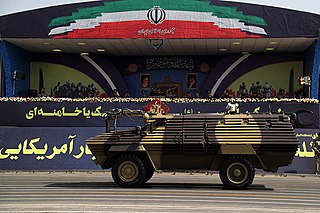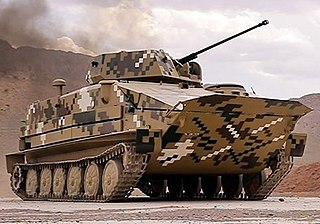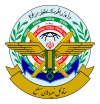
The BMP-1 is a Soviet amphibious tracked infantry fighting vehicle. BMP stands for Boyevaya Mashina Pyekhoty 1, meaning "infantry fighting vehicle, 1st serial model". The BMP-1 was the first mass-produced infantry fighting vehicle (IFV) of the Soviet Union. It was called the M-1967, BMP and BMP-76PB by NATO before its correct designation was known.

The M113 is a fully tracked armored personnel carrier (APC) that was developed and produced by the FMC Corporation. The M113 was sent to United States Army Europe to replace the mechanized infantry's M59 APCs from 1961. The M113 was first used in combat in April 1962 after the United States provided the South Vietnamese Army (ARVN) with heavy weaponry such as the M113, under the Military Assistance Command, Vietnam (MACV) program. Eventually, the M113 was the most widely used armored vehicle of the U.S. Army in the Vietnam War and was used to break through heavy thickets in the midst of the jungle to attack and overrun enemy positions. It was largely known as an "APC" or an "ACAV" by the allied forces.

The BMD-1 is a Soviet airborne amphibious tracked infantry fighting vehicle, which was introduced in 1969 and first seen by the West in 1970. BMD stands for Boyevaya Mashina Desanta. It can be dropped by parachute and although it resembles the BMP-1 it is in fact much smaller. The BMD-1 was used as an IFV by the Soviet Army's airborne divisions. An improved variant of the BMD-1 was developed, the BMD-2. The BMD-1 also provided a basis for the BTR-D airborne multi-purpose tracked APC.

The ZU-23-2, also known as ZU-23, is a Soviet towed 23×152mm anti-aircraft twin-barreled autocannon. ZU stands for Zenitnaya Ustanovka – anti-aircraft mount. The GRAU index is 2A13.

The BTR-80 is an 8×8 wheeled amphibious armoured personnel carrier (APC) designed in the USSR. It was adopted in 1985 and replaced the previous vehicles, the BTR-60 and BTR-70, in the Soviet Army. It was first deployed during the Soviet–Afghan War.

Heavy Industries Taxila, is a Pakistani state-owned defence, military contractor, engineering conglomerate, and military corporation located in Taxila, Punjab, Pakistan.

The BTR-40 is a Soviet non-amphibious, wheeled armoured personnel carrier and reconnaissance vehicle. It is often referred to as the Sorokovka in Soviet service. It is also the first mass-produced Soviet APC. It was eventually replaced in the APC role by the BTR-152 and in the scout car role by the BRDM-1.

Boragh or Boraq is an Iranian-made armoured personnel carrier. Boragh is believed to be a reverse engineered and upgraded model of the Chinese Type 86 (BMP-1). The upgrades include a reduction in weight, a higher road speed, and stronger armor. The vehicle is fully amphibious and is fitted with an NBC protection system and infra-red night vision equipment.

The WZ-551 is a Chinese wheeled infantry fighting vehicle family. The name WZ-551 actually covers two families of vehicles with the official designations in the People's Liberation Army (PLA) of Type 90 and Type 92. Over 3,000 WZ-551s are in service with the PLA, where they are used by medium mechanized infantry units.

The Type 63 is a Chinese armoured personnel carrier that entered service in the late 1960s. It was the first armoured vehicle designed in China without Soviet assistance. The design is simple and is comparable to other APCs of its time such as the M113.

An armoured personnel carrier (APC) is a broad type of armoured military vehicle designed to transport personnel and equipment in combat zones. Since World War I, APCs have become a very common piece of military equipment around the world.

Throughout its history, the Irish Army has used a number of armoured fighting vehicles.

The Rakhsh is a lightweight Iranian 4x4 cross-country armoured personnel carrier developed and produced by DIO's Shahid Kolah Dooz Industrial Complex and named after Rakhsh, the mythical horse of Rostam in Shahnama. It is probably based on a proven 4 × 4 cross-country chassis present in Iran before and is in service of Iranian Police, Iranian Army, IRGC and Sudan.

The Type 08 is a family of eight-wheeled amphibious, modular armored vehicle developed by Norinco for infantry fire support, battlefield logistics and quick reaction operations. It is a recent People's Republic of China produced Infantry fighting vehicle for People's Liberation Army Ground Force and People's Liberation Army Marine Corps.
The K808/806 White Tiger wheeled armored personnel carrier is family of 8x8 and 6x6 armored vehicles. Developed by Hyundai Rotem as a private venture in 2012, the Korean Army declared a plan to acquire 600 6×6 and 8×8 wheeled APCs in order to help build rapid response forces molded after U.S. Stryker combat brigades, according to the Defense Acquisition Program Administration (DAPA). Hyundai Rotem, a, made the K808/806 in competition with the Doosan Black Fox and Samsung Techwin MPV, and eventually won the competition.
Operation Fath 1, or Operation Wahdat, was a joint Iranian and Iraqi Kurdish special operation conducted by Iran's IRGC special forces and Iraqi Kurdish partisans of Patriotic Union of Kurdistan (PUK) in 11 and 12 October 1986 in Kirkuk area of northern Iraq during the Iran–Iraq War. The Iranian and Kurdish forces infiltrated into the area and successfully attacked economic and military targets with minimal losses of their own.

The Makran IFV, an Iranian armoured personnel carrier (APC), is the highly modernized and upsized copy of the BTR-50 APC. The vehicle is produced and designed by the Research and Self-Sufficiency Jihad Organization. It was unveiled in June 2020 by the Islamic Revolutionary Guard Corps. The vehicle is named after the Makran coastal region, a region that stretches between Iran and Pakistan. While the Makran is technically an infantry fighting vehicle, it has a large troop compartment as it is based on the BTR-50, allowing it to dual function as an armoured personnel carrier.















